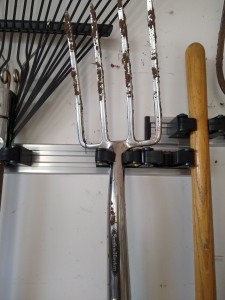 Nineteenth century poets, like John Keats, were fond of odes. Keats is particularly famous for a relatively short one extolling the beauty of a Grecian urn, and a longer one about a nightingale. If only he had lived long enough to be introduced to the sturdy garden fork that hangs in silence on my garage wall. Its many virtues would have merited at least 40 lyrical lines.
Nineteenth century poets, like John Keats, were fond of odes. Keats is particularly famous for a relatively short one extolling the beauty of a Grecian urn, and a longer one about a nightingale. If only he had lived long enough to be introduced to the sturdy garden fork that hangs in silence on my garage wall. Its many virtues would have merited at least 40 lyrical lines.
While not as antiquated as Keats’ Grecian urn, my garden fork is no spring chicken. It was made for Smith and Hawken, a once trendy garden and gardenalia supply company that existed from 1979 to 2009. It was part of a spade and fork set given to me when I retired as president of one of my town’s civic organizations. Then and now, it is beautiful thing, about four feet tall with a polished wood shaft and sturdy, stainless steel tines.
I put the spade to work the day after I received it and have used it hundreds of times over the years. It is no longer as pretty as it was on that first day, but has held up very well and done yeoman-like work in my compacted garden soil.
The fork is another story. It is one of three that I own, and by far the most attractive of the trio. It has kept its good looks because I have hardly used it over the years. Why? Who knows? Other tools seemed more useful at various times and I was simply not in the habit of grabbing the garden fork when I went out to labor in the beds and borders.
All of that changed a few weeks ago when I set out to attack a particularly weedy and compacted area in my front garden. Tenacious grass had crept into the beds, collaborating with deep-rooted onion grass and shallow-rooted spring weeds to commit acts of horticultural evil. In short, the area was a mess at a time when I needed weed-free soil in which to install all the young plants that arrive daily from the mail order vendors.
I was raising my head at the end of the process of replacing the filament spool on my string trimmer when the tines of the garden fork caught my eye. At that moment, it was not a mere garden tool, but the answer to a prayer. I grabbed it and attacked the compacted soil.
The sharp tines made short work of the job, getting down into the soil more efficiently and effectively than the blade of the spade. I was able to lift clods of clay soil with one thrust that would have taken twice the effort with other tools. Even the big clumps of onion grace yielded—bulbs, roots and all. This is especially important because when onion grass bulbs stay in the soil, they go to work under the soil and reproduce prolifically, compounding next fall’s weeding chores.
Now the garden fork has become so indispensible that I fear the spade may feel neglected. I will use the fork to dig out some much-loved old rosebushes that have contracted the invariably fatal and highly contagious rose rosette disease. The fork will help me get down to the roots easily. Once I am done with that, I will soak the tines in a bleach solution and rub down the shaft and handle with disinfectant to prevent spread of the virus. Good tools can stand up to that kind of treatment.
Replanting other non-rose perennials in the spaces vacated by those diseased roses will also be easier with the fork, as will creating new planting holes in other parts of the garden for the replacement roses. In addition to its other virtues, the fork will go a long way in reducing the physical—if not psychological—misery of having to take out favorite shrubs and rearrange the planting scheme.
Garden forks are also handy in digging soil that is laced with rocks or shrub or tree roots. A spade will hit a big root or rock and stop. A good, sturdy garden fork like mine can wiggle between roots or rocks, lessening the labor, not to mention the gardener’s frustration level.
Of course, there are some situations where the spade still holds the edge. Sandy soil slips between fork tines; a spade will do a better job of clearing out holes. Shallow-rooted weeds, like chickweed, can probably be removed with a hand fork or a hoe. A good Japanese gardening knife—sometimes known as a “hori hori’ knife—is often all that is necessary to remove individual onion grass or crabgrass plants.
Anyone needing new tools should invest in good ones. They may be more expensive, but will last longer. If you know a good gardener who is retiring or holding a house sale, check it out. I acquired some of my first and best garden tools at tag sales. For new tools and gardening supplies, one of the best vendors is Kinsman Garden Company, P.O. Box 428, Pipersville, PA 18947; (800)-733-4146; www.kinsmangarden.com.
